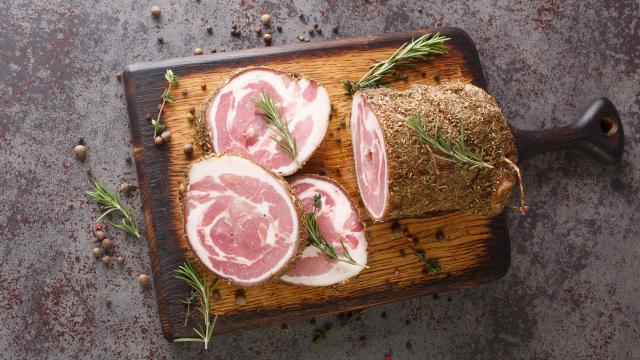Bacon is the rare meat so well-loved that we invite it into both sweet and savory foods. Both traditional and pork-free options offer robust salty and smoky flavors and the crisp or chewy textures we just can’t get enough of.
So let’s put bacon on everything! Here are some of the most popular iterations of bacon (including vegan), and why each one is a special salty snowflake worthy of a spot in your fridge.
Streaky bacon

Where I’m from (the U.S.), this is just called bacon. Other regions will refer to this fatty slice as streaky bacon or side bacon. Cut in strips, thick or thin-cut, this bacon is made from the belly of the pig, cured, and smoked. It’s obvious where the term streaky comes from: The slices of meat from this part of the animal are striped with fat and muscle, giving it that streaky look. Depending on the spot from which your bacon is being cut, the fat composition can vary from around 45% to 70%.
Streaky bacon sold in stores can be cut in thick slices (about a 1/4-inch thick), or in thin slices, (about 1/8-inch thick), offering different textures once cooked. Some stores even sell cured pork belly in hunks, which allows you to slice your own bacon, according to your preferred thickness.
Unsmoked bacon
I associate bacon with a smoky flavor, and while most bacon in the U.S. is smoked, it doesn’t have to be. Unsmoked bacon might be called salt pork or green bacon. While this is more popular in the U.K. and Ireland, you can still find different forms of unsmoked bacon in the U.S. under different names (I’ll dive into those later). Whatever the name, unsmoked bacon is lovely sliced up into small pieces to add salt and fat to dishes, and it can be cooked in larger slices for a more chewy texture.
Uncured bacon
Uncured bacon is a bit of a misnomer. It’s still cured. Bacon is typically wet-brined before smoking (though it can be dry brined with a rub of the same ingredients, without water), and the brine usually includes synthetic nitrites and nitrates. Instead, “uncured” bacon is cured with the naturally occurring nitrites in celery powder. As Lifehacker’s Senior Health Editor Beth Skwarecki puts it in this article about other misleading food labels, “Bafflingly, the labeling regulations require that celery-cured bacon be labeled ‘uncured.’” It’s still cured.
Canadian bacon

Far less fatty and more rotund in shape, Canadian bacon isn’t cut from the belly of the pig, but from the loin. While this cut might include a portion of the fatty belly, the texture and flavor is closer to ham than streaky belly bacon. Even though it’s from a different pork cut, I include it in this list because, well, I think the matter warrants clarification. Canadian bacon is still typically brined and smoked, but the flavor is much less robust than that of streaky bacon. Canadian bacon tastes less salty, less smoky, and a tad sweet. The low fat content makes it perfect for cooking up chewy or tender, instead of crispy and brittle.
Pancetta
I told you we’d get to more unsmoked bacon. Pancetta is an Italian bacon that’s brined and cured but left unsmoked. Most notably different (and offering a fun change from your boring, straight-sliced pork belly), is the fact that the wide, flat section of belly is often tightly rolled and tied. The resulting giant pork tube is then thinly sliced to reveal a meaty swirl. That said, the pancetta in my local grocery store is normally sold as chunky cubes. I usually toss the pieces into a pan to render out the fat and flavor for use in larger dishes. Pancetta has all the salty richness of bacon, but without the smoke.
Lardons

While Canadian bacon is for lean salty pork lovers, lardons are for the folks that prize those stripes of fat. Lardons can be cut from the pork belly or fat back, which is, unsurprisingly, more fatty. They are typically cubes or chunky rectangles, and they can be made from smoky bacon or unsmoked salt pork. You don’t have to buy lardons; you can make them simply by slicing your bacon widthwise to make lots of fatty bacon matchsticks. Crisp them up in a pan and use them as a crunchy salad component, to start off a rich chowder recipe, or as a topping a casserole.
Alternative-meat bacon
Not a pork fan? You can cook turkey or duck in the style of pork bacon, with mouthwatering results. Turkey bacon is usually made by processing the turkey meat and reconstituting it into a slab that can be sliced thinly to mimic sliced bacon. Duck is already blessed with thick, fatty skin, so duck bacon is more often sliced from the breast to include a strip of this fat. Both can be cured and smoked to deliver big, bacon-y flavor.
Vegan bacon
The existence of vegan bacon is proof of how much of bacon’s allure is salt- and smoke-related, though a crisp and chewy texture doesn’t hurt either. There are store-bought varieties made from soy and tempeh, but you can make your own plant-based bacon from thinly shaved carrots, or use this wild recipe to make bacon from banana peels. The key is loading up the plant strips with plenty of flavor. While salt and umami can be taken care of with a few helpful friends (MSG, soy sauce, and plain old salt), you should also grab a bottle of liquid smoke from the grocery store. It’s usually next to the barbecue sauce, and it’ll help your endeavors enormously.

Leave a Reply
You must be logged in to post a comment.